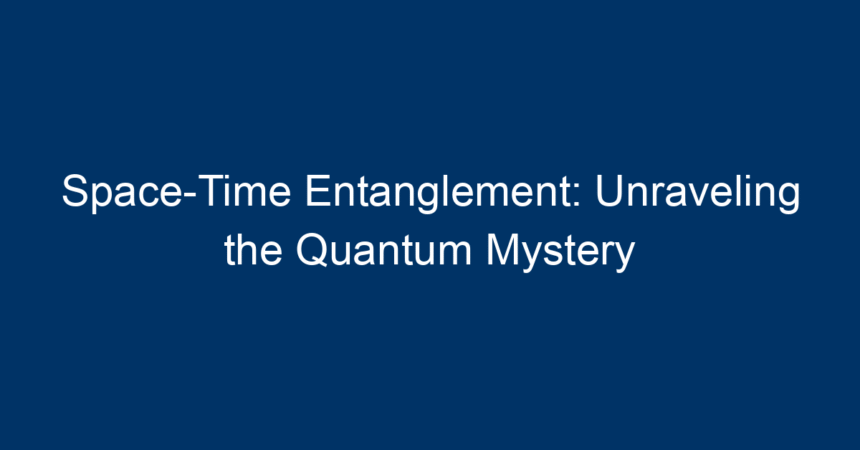Quantum physics has long captured the imagination of scientists and enthusiasts alike, pushing the boundaries of our understanding of the universe. Among the many enigmatic phenomena in this field, space-time entanglement stands out as one of the most profound. This article aims to delve into the complexities of space-time entanglement, elucidating its implications, challenges, and the tantalizing possibilities it holds for the future of science and technology.
What is Space-Time Entanglement?
At the heart of quantum mechanics is the concept of entanglement, a phenomenon where particles become interconnected in ways that classical physics cannot explain. When two particles are entangled, the state of one particle instantaneously influences the state of the other, regardless of the distance separating them. This "spooky action at a distance," a term coined by Albert Einstein, raises significant questions about the nature of reality.
The Basics of Entanglement
To understand space-time entanglement, it’s essential first to grasp quantum entanglement. Quantum theory tells us that the properties of particles, such as their position, momentum, and spin, exist in a superposition of states until measured. When entangled, measuring the state of one particle immediately provides information about the other, regardless of how far apart they are.
Beyond Traditional Boundaries
Space-time entanglement extends this idea beyond mere particle interactions to the very fabric of space and time. This phenomenon suggests that particles can be entangled across different regions of spacetime, suggesting a deeper relationship between quantum mechanics and general relativity.
The Historical Context of Space-Time Entanglement
Theoretical Foundations
The foundations of space-time entanglement are rooted in breakthroughs from the early 20th century. Albert Einstein’s theory of relativity introduced the idea of space and time as intertwined dimensions. Meanwhile, quantum mechanics, developed by figures like Max Planck and Werner Heisenberg, laid the groundwork for understanding particle behavior at the smallest scales.
In the 1930s, Einstein, Podolsky, and Rosen presented a thought experiment now known as the EPR paradox, which questioned the completeness of quantum mechanics. Their paper sparked a century-long debate regarding the nature of reality and locality in the quantum realm.
The Rise of Quantum Information Theory
In recent decades, the emergence of quantum information theory has opened new avenues for exploring space-time entanglement. Researchers like John Bell and David Deutsch have used concepts from information theory to investigate entanglement’s implications for both physics and technology.
The Science Behind Space-Time Entanglement
Quantum Mechanics Meets Relativity
Space-time entanglement bridges the gap between quantum mechanics and general relativity, suggesting that spacetime itself may be a network of interconnections rather than a static stage on which events unfold. According to physicists, this intersection forces us to reconsider fundamental concepts such as causality and locality.
The Role of Quantum Field Theory
Quantum field theory (QFT) provides the mathematical framework for understanding particle interactions. In this context, space-time entanglement can be viewed as a manifestation of the underlying quantum fields that permeate the universe. When particles interact, they exchange virtual particles, establishing a connection that transcends spatial separation.
The Holographic Principle
A particularly intriguing aspect of space-time entanglement is related to the holographic principle, a concept suggesting that all the information contained within a volume of space can be represented as a theory on the boundary of that space. This idea hints at profound implications for how we perceive the universe, blurring the lines between three-dimensional space and information.
Experimental Evidence of Space-Time Entanglement
Bell’s Theorem Tests
Numerous experiments have confirmed the predictions of quantum entanglement, notably tests of Bell’s theorem. These experiments consistently support the notion that entangled particles exhibit correlations that cannot be explained by classical physics, hinting at deeper connections across space and time.
Recent Breakthroughs
Recent advancements in technology have allowed for more sophisticated experiments. Researchers have been able to create and manipulate entangled particles across increasingly larger distances, providing compelling evidence for the existence of space-time entanglement. For instance, experiments using photons have demonstrated entanglement across distances exceeding several kilometers.
Implications of Space-Time Entanglement
Quantum Computing
One of the most exciting applications of space-time entanglement lies in quantum computing. By harnessing the power of entangled qubits, quantum computers can perform complex calculations at unprecedented speeds, opening doors to solving problems once deemed impossible.
Quantum Teleportation
Space-time entanglement is also fundamental to the concept of quantum teleportation, where the state of one particle is transferred to another without physical travel. This phenomenon has profound implications for secure communication, potentially revolutionizing data transfer and cybersecurity.
The Search for a Unified Theory
The quest to unify general relativity and quantum mechanics remains one of the greatest challenges in modern physics. Space-time entanglement could provide vital insights, leading to a deeper understanding of the fundamental forces of nature and the structure of the universe itself.
Challenges and Controversies
Interpretational Challenges
The implications of space-time entanglement are not without their challenges. Various interpretations of quantum mechanics, such as the Copenhagen interpretation and many-worlds theory, offer different perspectives on the reality of entangled states.
The Nature of Reality
Space-time entanglement forces us to confront questions about the nature of reality and existence. Are entangled particles merely a mathematical abstraction, or do they represent a fundamental feature of the universe? Addressing these questions will require philosophical inquiry and scientific rigor.
Experimental Limitations
While significant progress has been made, experimenting with space-time entanglement is still in its infancy. The complexity of measuring and manipulating entangled states presents significant technical challenges that require ongoing innovation and collaboration among researchers.
Conclusion
Space-time entanglement remains one of the most fascinating areas of study in modern physics. As we unravel the mysteries of this quantum phenomenon, we find ourselves on the brink of immense possibilities, from quantum computing and secure communication to a deeper understanding of the universe’s structure.
Actionable Insights
-
Stay Informed: Keep up with the latest developments in quantum mechanics and space-time entanglement by following reputable science publications and journals.
-
Engage with Technology: If you’re interested in quantum computing, consider exploring online courses or resources to understand the underlying principles and applications.
-
Participate in Discussions: Join forums or local science clubs to engage in discussions about the philosophical and scientific implications of space-time entanglement.
- Explore Further Reading: For those curious about the topic, books by authors like Brian Greene and Carlo Rovelli offer accessible insights into the realm of quantum physics and the mysteries of the universe.
In this age of rapid technological advancement and groundbreaking scientific inquiry, space-time entanglement serves as a reminder of the mysteries that still lie ahead—a tantalizing invitation to explore the unknown.




